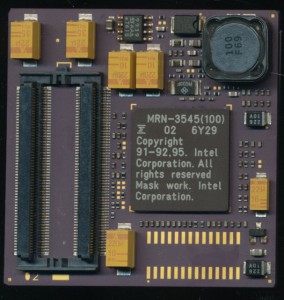August 10th, 2014 ~ by admin

Fujitsu MRN-3545 (100)
100MHz Pentium with no L2 Cache
We have seen Fujitsu MCM Pentiums before. 120MHz, 133MHz 150MHz and MMX ones. One is pictured in the article on the MicroModule Systems Gemini here. The 100MHz module is similar, though it is missing the L2 cache tag RAM (256 kbit chip on the top of the package) as well as the 2 cache RAM chips normally installed on the backside of the module. It would appear that Fujitsu offered these modules with the cache being optional. There was a 133MHz version (MRN-3548) with cache, and one (MRN-3549) without cache.
These processors were typically used in environmentally challenging environments. Panasonic famously used them in their ToughBook CF25, the beginning of a line of highly durable laptop in 1996. Some of these applications were sealed environments, they did not have vents, or active cooling. This obviously makes cooling a challenge. Removing the L2 cache, while causing a significant hit in performance, would alleviate some of the heat generation.
We consider L2 cache to be essential, but many applications do not require it. Intel infamously removed the L2 Cache completely from the first Celeron processors and while they worked, they were not particularly competitive performance wise. When competing against wind, rain dirt, and droppage? L2 cache may not be so important
February 14th, 2011 ~ by admin
The last week has been filled with new processor announcements, mainly for phones, but cameras as well. (yes they run some powerful processors now too).
TI is barely shipping products with its dual-core OMAP 4 applications processor and has already announced its successor, the OMAP 5. The OMAP 5 will be a 2GHz dual core ARM Cortex-A15 (the next ARM generation after the A9). It also includes a pair of ARM Cortex-M4 processor. the Cortex-M4 is a 150-300MHz microcontroller oriented processor. This will allow the OMAP 5 to run basic background tasks on the slower (lower power) cores while reserving the high power cores for tasks that actually need them, increasing battery life.
Broadcom continues its drive to enter the smart phone business with the BCM28150, a 1.1GHz dual core ARM Cortex-A9 compatible with Google Android. In December they released the BCM2157, a 500MHz dual core ARM11 processor for low-end smart phones
Samsung decided to rename the Orion processor (announced back in November) to the Exynos 4210. A bit of a mouthful compared to Orion.

Fujitsu MB91696AM
Qualcomm showed off the APQ8060 in HP’s new TouchPad. This is a dual core version Snapdragon processor we have become very familiar with. Qualcomm has an architecture license from ARM so they are free to design their own cores without having to stick to ARMs own implementations (such as Cortex-A9 etc). This gives Qualcomm more flexibility to design in features they need, and tweak design more best efficiency.
Smart phones aren’t the only ones getting new processors. Digital cameras now require immense amount of processing power (especially to handle 1080p video recording. Fujitsu (yah, they still make a lot of processors) announced the Milbeaut MB91696AM. This is a dual core ARM processor with many other DSP functions capable of handling 14Mpixel shooting at 8fps, as well as full HD video.



